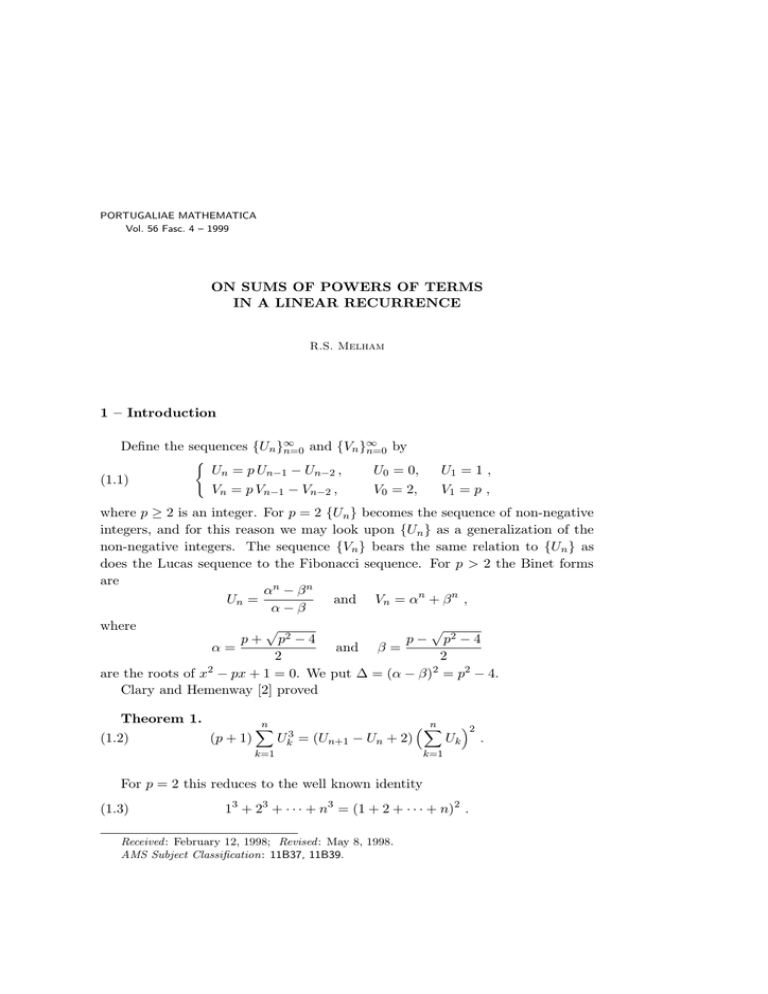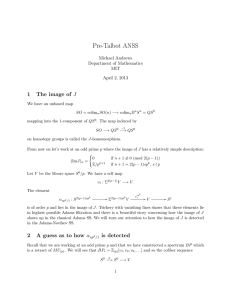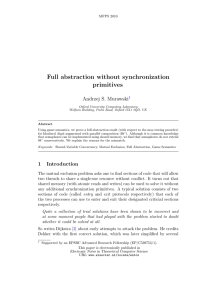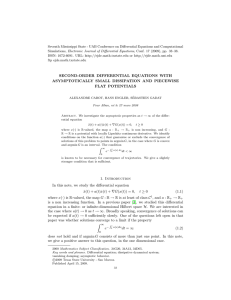ON SUMS OF POWERS OF TERMS IN A LINEAR RECURRENCE
advertisement

PORTUGALIAE MATHEMATICA
Vol. 56 Fasc. 4 – 1999
ON SUMS OF POWERS OF TERMS
IN A LINEAR RECURRENCE
R.S. Melham
1 – Introduction
∞
Define the sequences {Un }∞
n=0 and {Vn }n=0 by
(1.1)
(
Un = p Un−1 − Un−2 ,
Vn = p Vn−1 − Vn−2 ,
U0 = 0,
U1 = 1 ,
V0 = 2,
V1 = p ,
where p ≥ 2 is an integer. For p = 2 {Un } becomes the sequence of non-negative
integers, and for this reason we may look upon {Un } as a generalization of the
non-negative integers. The sequence {Vn } bears the same relation to {Un } as
does the Lucas sequence to the Fibonacci sequence. For p > 2 the Binet forms
are
αn − β n
and Vn = αn + β n ,
Un =
α−β
where
p
p
p + p2 − 4
p − p2 − 4
α=
and β =
2
2
2
2
are the roots of x − px + 1 = 0. We put ∆ = (α − β) = p2 − 4.
Clary and Hemenway [2] proved
Theorem 1.
(1.2)
(p + 1)
n
X
k=1
Uk3 = (Un+1 − Un + 2)
n
³X
k=1
Uk
´2
For p = 2 this reduces to the well known identity
(1.3)
13 + 23 + · · · + n3 = (1 + 2 + · · · + n)2 .
Received : February 12, 1998; Revised : May 8, 1998.
AMS Subject Classification: 11B37, 11B39.
.
502
R.S. MELHAM
Similar results on sums of powers of integers have a long history. If k is a
positive integer write
Tk (n) = (1 + 2 + · · · + n)k
Sk (n) = 1k + 2k + · · · + nk .
and
Then a result which extends (1.3) is
Theorem 2.
(1.4)
Tk (n) =
1
2k−1
Xµ
k
2i−1
¶
S2k+1−2i (n) ,
the sum being taken over those i for which 2 ≤ 2 i ≤ k + 1.
The first few instances of (1.4) are
(1.5)
T2 (n) = S3 (n) ,
1
3
S3 (n) + S5 (n) ,
4
4
1
1
(1.7)
T4 (n) = S5 (n) + S7 (n) .
2
2
Theorem 1 has been rediscovered many times. It occurs in a 1952 paper
of Piza [5], and according to MacDougall [4] it was known as far back as 1877
(Lampe) and 1878 (Stern). In 1997 G.L. Cohen, a colleague of the present writer,
also rediscovered Theorem 1, and thus provided the motivation for this paper.
Chapter xiv of Lucas [3] contains an excellent historical survey on sums of powers
of integers. In a recent paper, which also contains a wealth of historical material,
Beardon [1] generalized (1.3) by describing all polynomial relations that exist
between any two of the Si .
Our object in this paper is to produce further identities like (1.2) which involve
higher powers. Our main results are stated as Theorems 3, 4 and 5 in Section 3.
(1.6)
T3 (n) =
2 – Some preliminary results
We require the following:
(2.1)
(2.2)
(2.3)
(2.4)
∆Un3 = U3n − 3 Un ,
∆2 Un5 = U5n − 5 U3n + 10 Un ,
∆3 Un7 = U7n − 7 U5n + 21 U3n − 35 Un ,
U5n = ∆2 Un5 + 5 ∆Un3 + 5 Un ,
ON SUMS OF POWERS OF TERMS IN A LINEAR RECURRENCE
503
U7n = ∆3 Un7 + 7 ∆2 Un5 + 14 ∆Un3 + 7 Un ,
(2.5)
(2.6)
Vm Un = Um+n − Um−n ,
(2.7)
∆Um Un = Vm+n − Vm−n ,
(2.8)
U2n = Un Vn ,
(2.9)
2
V2m − 2 = ∆Um
,
(2.10)
2
Un2 + Un+1
= p Un Un+1 + 1 ,
(2.11)
4
2
Un4 + Un+1
= (p2 −2) Un2 Un+1
+ 2p Un Un+1 + 1 ,
(2.12)
2
3
6
+ 3p Un Un+1 + 1 .
+ (3p2 −3) Un2 Un+1
= (p3 −3p) Un3 Un+1
Un6 + Un+1
Identities (2.1)–(2.3) are obtained from the Binet form for Un by taking the
appropriate power. Identities (2.4) and (2.5) are obtained from (2.1)–(2.3). Identities (2.6) and (2.7) are special cases of (8) and (10) respectively in [2], while
(2.8)–(2.10) follow immediately from the Binet forms. Identities (2.11) and (2.12)
follow from (2.10) after taking appropriate powers.
If, for the sequences Un and Vn , we highlight the dependence on the parameter
p by writing Un (p) and Vn (p), then we have the following composition formulas
which appear as (17) and (18) in [2]
(2.13)
Vrn (p) = Vn (Vr (p)) ,
(2.14)
Urn (p) = Ur (p) Un (Vr (p)) .
In the work which follows we need the following lemmas.
Lemma 1. If m is a positive integer, then
n
X
U2mk =
k=1
Umn Um(n+1)
.
Um
Proof: By using the Binet form for U2mk and the formula for the sum of a
geometric progression, we obtain
n
X
U2mk =
k=1
=
U2mn+2m − U2mn − U2m
V2m − 2
V2mn+m Um − Um Vm
2
∆Um
and the result follows from (2.7).
(by (2.6), (2.8) and (2.9)) ,
504
R.S. MELHAM
Lemma 2.
U3n U3(n+1) = ∆2 (Un Un+1 )3 + 3p ∆(Un Un+1 )2 + (3∆ + 9) Un Un+1 .
Proof: From (2.1) we have
2
+ 3)
U3n U3(n+1) = Un Un+1 (∆Un2 + 3) (∆Un+1
³
´
2
2
)+9 ,
+ 3 ∆(Un2 + Un+1
= Un Un+1 ∆2 Un2 Un+1
and the result follows from (2.10).
Lemma 3.
U5n U5(n+1) = ∆4 (Un Un+1 )5 + 5p ∆3 (Un Un+1 )4 + 5 (2p2 − 1) ∆2 (Un Un+1 )3
+ 5p (2p2 − 3) ∆(Un Un+1 )2 + 5 (∆2 + 5∆ + 5) Un Un+1 .
Proof: From (2.4) we have
4
2
U5n U5(n+1) = Un Un+1 (∆2 Un4 + 5 ∆Un2 + 5) (∆2 Un+1
+ 5 ∆Un+1
+ 5) .
We complete the proof by multiplying the terms in the brackets and using (2.10)
and (2.11).
In precisely the same manner, using (2.5) and (2.10)–(2.12), we can prove
Lemma 4.
U7n U7(n+1) = ∆6 (Un Un+1 )7 + 7p ∆5 (Un Un+1 )6 + 7 (3p2 − 1) ∆4 (Un Un+1 )5
+ 35p (p2 − 1) ∆3 (Un Un+1 )4 + 7 (5p4 − 10p2 + 2) ∆2 (Un Un+1 )3
+ 7p ∆(3∆2 + 14∆ + 14) (Un Un+1 )2
+ 7 (∆3 + 7∆2 + 14∆ + 7) Un Un+1 .
3 – The main results
3 = U − 3 U , and using Lemma 1 we obtain
From (2.1) we have ∆U2k
6k
2k
∆
n
X
k=1
3
U2k
=
U3n U3(n+1)
− 3 Un Un+1 .
U3
ON SUMS OF POWERS OF TERMS IN A LINEAR RECURRENCE
505
By Lemma 2 this becomes
n
X
U3
3
U2k
= ∆(Un Un+1 )3 + 3p (Un Un+1 )2 ,
k=1
and Lemma 1 with m = 1 yields
(3.1)
U3
n
X
3
U2k
=∆
k=1
µX
n
U2k
k=1
¶3
+ 3p
µX
n
k=1
U2k
¶2
.
To convert (3.1) to a form involving consecutive subscripts we use (2.14) with
r = 2. That is, in (3.1) we make the substitution U2k (p) = p Uk (p2 − 2). Finally,
√
if we put U3 = p2 − 1 and ∆ = p2 − 4, and replace p by p + 2 in order to restore
the original parameter p, we obtain
Theorem 3.
(3.2)
(p + 1)
n
X
k=1
Uk3 = (p − 2)
µX
n
k=1
Uk
¶3
+3
µX
n
k=1
Uk
¶2
.
Now (3.2) reduces to (1.3) when p = 2. We also note that (3.2) is equivalent
to (1.2). Indeed we can obtain (1.2) if we first factorise the right side of (3.1) and
then convert to a form involving consecutive subscripts.
Next we obtain an analogue of (3.2) involving fifth powers. From (2.2) we
5 =U
have ∆2 U2k
10k − 5 U6k + 10 U2k , and using Lemma 1 we obtain
U3 U5 ∆2
n
X
k=1
5
U2k
= U3 U5n U5(n+1) − 5 U5 U3n U3(n+1) + 10 U3 U5 Un Un+1 .
After we make the necessary substitutions using Lemma 2 and Lemma 3 this
identity becomes
U3 U5
n
X
5
U2k
= U3 ∆2 (Un Un+1 )5 + 5p U3 ∆(Un Un+1 )4
k=1
+ 5p4 (Un Un+1 )3 − 5p3 (Un Un+1 )2 .
Next we use Lemma 1 to replace each occurrence of Un Un+1 by nk=1 U2k . Finally
if we note that U5 = p4 − 3p2 + 1, and convert to consecutive subscripts as before,
we obtain
P
506
R.S. MELHAM
Theorem 4.
2
(p + 1) (p + p − 1)
n
X
Uk5
k=1
= (p + 1) (p − 2)
2
µX
n
+ 5 (p + 2)
µX
n
µX
n
Uk
k=1
+ 5 (p + 1) (p − 2)
(3.3)
Uk
¶5
Uk
k=1
k=1
¶3
−5
¶4
µX
n
Uk
k=1
¶2
.
When p = 2 (3.3) becomes
1
4
T3 (n) − T2 (n) ,
3
3
S5 (n) =
which can be obtained from (1.5) and (1.6).
Next we obtain an identity involving seventh powers. Since the algebra is
lengthy (but straightforward) we omit the details. Using (2.3) together with
Lemma 1 we have
3
U3 U5 U7 ∆
n
X
k=1
7
= U3 U5 U7n U7(n+1) − 7 U3 U7 U5n U5(n+1)
U2k
+ 21 U5 U7 U3n U3(n+1) − 35 U3 U5 U7 Un Un+1 .
Then we use Lemmas 2–4, together with Lemma 1, to express the right side as a
P
polynomial in nk=1 U2k . Finally, noting that U7 = p6 − 5p4 + 6p2 − 1, we change
to consecutive subscripts to obtain
Theorem 5.
2
3
2
(p + 1) (p + p − 1) (p + p − 2p − 1)
= (p+1) (p−2)3 (p2 +p−1)
µX
n
k=1
(3.4)
+ 7 (p + 1) (2p − 1) (p2 − 4)
− 7 (p + 2) (2p + 1)
µX
n
k=1
Uk
n
X
k=1
¶7
Uk + 7 (p+1) (p−2)2 (p2 +p−1)
µX
n
k=1
¶3
Uk7 =
Uk
µX
n
k=1
¶5
+ 35 p (p + 1)
+ 7 (2p + 1)
µX
n
k=1
µX
n
k=1
Uk
¶2
.
Uk
¶4
¶6
Uk
ON SUMS OF POWERS OF TERMS IN A LINEAR RECURRENCE
507
When p = 2 (3.4) becomes
S7 (n) = 2 T4 (n) −
1
4
T3 (n) + T2 (n) ,
3
3
which can be obtained from (1.5)–(1.7).
4 – Concluding remarks
Interestingly, in each of (3.2)–(3.4) the sum of the polynomial coefficients on
the right side is equal to the polynomial coefficient on the left side. We have
not been able to detect any other pattern in these coefficients. Our method of
deriving these identities suggests that there are higher power analogues. Is there
a more direct way to derive them? Is there a general formula which encompasses
all such identities?
We conclude by making an unusual observation. If we denote the k-th deriva(k)
(0)
tive (with respect to p) of Vn by Vn , where Vn = Vn , then (2.10)–(2.12) can
be written respectively as
(0)
Un Un+1 + V1
(0)
2
Un2 Un+1
+ V2
2
= V1
Un2 + Un+1
4
Un4 + Un+1
= V2
Un6
+
6
Un+1
=
(0)
3
V3 Un3 Un+1
+
(1)
,
(1)
Un Un+1 +
(2)
(1)
2
V3 Un2 Un+1
V2
,
2!
(2)
(3)
V
V
+ 3 Un Un+1 + 3 .
2!
3!
After checking that this pattern continues for several more cases, we make the
following conjecture.
Conjecture: If k is a positive integer then
2k
Un2k + Un+1
=
(r)
k
X
Vk
r=0
r!
k−r
Unk−r Un+1
.
REFERENCES
[1] Beardon, A.F. – Sums of powers of integers, The American Mathematical Monthly,
103(3) (1996), 201–213.
[2] Clary, S. and Hemenway, P.D. – On sums of cubes of Fibonacci numbers. In
“Applications of Fibonacci Numbers”, 5 (G.E. Bergum et al., Eds.), Kluwer Academic Publishers, 1993, 123–136.
508
R.S. MELHAM
[3] Lucas, Édouard – Théorie des Nombres, Paris, Gauthier-Villars, 1891.
[4] MacDougall, J.A. – Identities relating the sums of powers of integers – An exercise in generalization, Australian Senior Mathematical Journal, 2(1) (1988), 53–62.
[5] Piza, P.A. – Powers of sums and sums of powers, Mathematics Magazine, 25(3)
(1952), 137–142.
R.S. Melham,
School of Mathematical Sciences, University of Technology, Sydney,
PO Box 123, Broadway, NSW 2007 – AUSTRALIA







